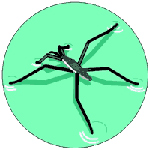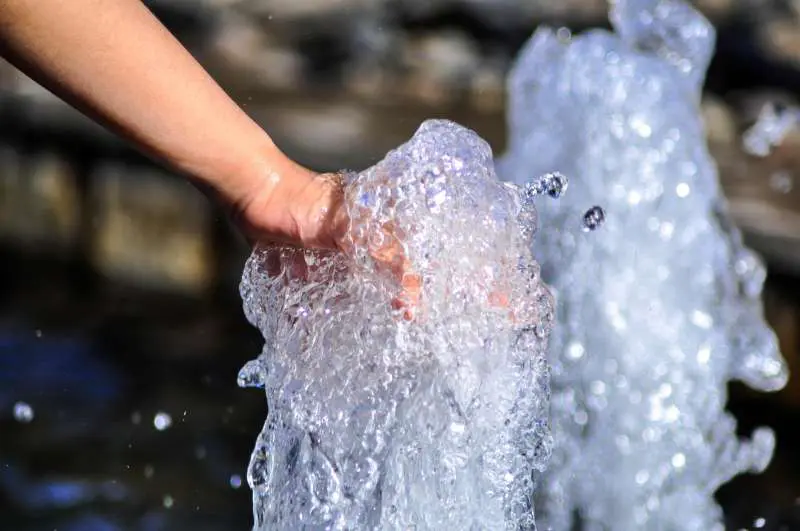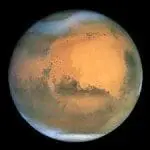Water! We drink it, wash in it, cook with it, swim in it and generally take it for granted. This clear, tasteless and odorless liquid is so much part of our lives that we hardly ever think about its amazing properties. We would die in a few days without water—and our bodies are 65% water. Water is necessary to dissolve essential minerals and oxygen, flush our bodies of waste products, and transport nutrients around the body where needed. Water is the only substance that has these properties. And as we shall see, it has many more fascinating features that suggest that it has been designed ‘just right’ for life.
Liquid
There are three states of matter: solid, liquid, and gas. All three are essential for living things.
- The solid state maintains its shape.
- Liquid is able to flow and take up the shape of its container, while keeping the same total volume.
- A gas expands to fill both the shape and size of its container.
For molecules to react together, it is best to have them close to each other, but free to move around. This is just what the liquid state provides, so it is ideal for all the thousands of chemical reactions occurring in every cell of every organism.
But of all the temperatures in the universe from the –270°C (–454°F) of outer space to the tens of millions of degrees inside the hottest stars, water is liquid in a very narrow range. At normal atmospheric pressure, water is only liquid from 0–100°C (32–212°F). It should not then be surprising that Earth is the only place in the universe known to have liquid water. And this depends on having the right kind of star—neither too bright nor too dim, and thus neither too big nor too small. And the planet must be at the right distance from it [see also The sun: our special star].
Why is ice so slippery?Many people enjoy winter sports such as ice skating and skiing. What makes ice so slippery, allowing these fun activities? Many people believe that it comes from pressure melting the ice and forming a lubricating liquid layer. True, it is well-known to physical chemists that applied pressure tends to help form the substance which takes up the least room. Therefore pressure will favour production of water from ice (melting), so its melting point will decrease. But the effect is much smaller than many people think—about 100 times normal air pressure lowers the melting point by only one Celsius degree.3 So there is no way that this effect could be responsible for ice skating, and certainly not for skiing where the pressure is far less. Nor could it have caused planes to melt ice and sink 75 metres (250 feet)—see The lost squadron. The true reason is yet another unusual property—the molecules on the surface of ice vibrate much more than usual in a solid, although they don’t move around. This gives the surface a ‘quasi-liquid’ character, i.e. liquid-like but not liquid.4 |
Temperature buffer
Another very important property of water is its high specific heat. This means it takes a lot of energy to heat it (about ten times as much as the same mass of iron), and it must lose a lot of energy to cool down. So the vast bodies of water on earth help keep the earth’s temperature fairly steady. On the other hand, land masses heat up and cool down more quickly. When combined with the fairly steady temperature of water bodies, this is a good thing. It means different parts of the atmosphere are heated differently, which generates wind. This is essential for keeping the air fresh.

Surface tension on water is easily seen when insects walk across the surface without sinking.
Surface tension
Water has a very high surface tension, the force trying to keep the surface area as small as possible. It is higher than that of a syrupy liquid like glycerol. Surface tension tends to make bubbles and drops spherical, and is strong enough to support light objects, including some insects. More importantly, this means that biological compounds can be concentrated near the surface, speeding up many of life’s important reactions.
Water’s power
Although water usually appears placid, if a lot of it is moving fast enough, it can move car-sized boulders and carve deep canyons, even cutting into solid rock. When flowing very fast, an especially destructive process called cavitation occurs—see Interview with Dr Edmond Holroyd for more details.
Also, on a chemical level, it quickly breaks down many important large molecules in living cells. While living cells have many ingenious repair mechanisms, DNA cannot last very long in water outside a cell.5 A recent article in New Scientist also described this as a ‘headache’ for researchers working on evolutionary ideas on the origin of life.6 It also showed its materialistic bias by saying this was not ‘good news’. But the real bad news is surely the faith in evolution (everything made itself), which overrides objective science. [For a more technical explanation, see Origin of life: the polymerization problem.]
When liquids evaporate, they draw in heat from their surroundings. This means that we have a useful means of keeping cool: sweating. An essential part of this is water’s high latent heat of vaporization. This means it takes much more energy to evaporate water than most other liquids. So we need to perspire comparatively little water to keep cool; if we sweat nearly any other liquid, the amount we would need would be enormous.
Super solvent
Water is one of the nearest things we have to a “universal solvent”. Many minerals and vitamins can be transported throughout the body after being dissolved. Dissolved sodium and potassium ions are essential for nerve impulses. Water also dissolves gases, such as oxygen from the air, enabling water-living animals to use oxygen. Water, a major component of blood,1 also dissolves carbon dioxide, a waste product from energy production in all cells, and transports it to the lungs, where it can be breathed out.2
However, a truly universal solvent would be no use, because no container could store it! But water is repelled by oily compounds, so our cells have membranes made of these. Many of our proteins have partly oily regions, and they tend to fold together, repelled by the surrounding water. This is partly responsible for the many and varied shapes of proteins. These shapes are essential for carrying out functions vital for life.
Insight into ice
A vital and very unusual property of water is that it expands as it freezes, unlike most other substances. That is why icebergs float. In fact, water contracts normally as it is cooled, until it reaches 4°C (39.2°F), when it starts to expand again. This means that icy-cold water is less dense, so tends to move upwards. This is very important. Most liquids exposed to cold air would cool, and the cold liquid would sink, forcing more liquid to rise and be cooled by the air. Eventually all the liquid would lose heat to the air and freeze, from the bottom up, till completely frozen. But with water, the cold regions, being less dense, stay on top, allowing the warmer regions to stay below and avoid losing heat to the air. This means that the surface may be frozen, but fish can still live in the water below. But if water were like other substances, large bodies of water, such as North America’s Great Lakes, would be frozen solid, with dire effects on life on earth as a whole.
Did you know?
- The earth is 70% covered by water.
- Only 1% of the world’s water is readily available for human consumption. Approximately 97% is too salty and 2% is ice.
National Oceanic & Atmospheric Administration (NOAA), U.S. Dept Commerce

The earth’s vast ice caps and glaciers contain a staggering 29 million cubic kilometres (7 million cubic miles) of water which is about 2% of the total on earth. The oceans contain 1,370 million cubic kilometres and the total amount of water falling as rain on land each year is approximately 110,300 cubic kilometres.
- Australia is the world’s driest inhabited continent having the least runoff and 70% desert.
- It takes about 150,000 litres of water to make a family car.
- Only 1% of household water usage is for drinking. The rest goes on lawns, showers, etc.
- A household toilet flushes about 150 litres of water per day.
- A continuously dribbling tap wastes 600 litres of water per day. A dripping tap per day (1 drip per second) uses 30 litres.
- Garden mulching reduces evaporation by 75%.
- An average garden sprinkler uses 1000 litres per hour.
- Natural water has in it small amounts of dissolved mineral salts, which give it a taste. Pure water is tasteless.
(Household figures are averages but will vary depending on personal habits and appliance design.)
Why is water unique?The smallest building block of water is the water molecule. This comprises two hydrogen atoms attached to an oxygen atom in a V-shape, with an angle of 104°. It is polar, that is the oxygen atom has a negative electrical charge while the two hydrogen atoms are positive. This is why water dissolves so many things, like salt, which also have electrically charged building blocks; while water won’t dissolve oil which has uncharged molecules. Also, it is attracted quite strongly to other water molecules by hydrogen bonds. These bonds are ten times weaker than typical chemical bonds, but strong enough to make water liquid at room temperature, while a similar compound, hydrogen sulfide, lacking hydrogen bonds, is a gas. Hydrogen bonds are also responsible for water’s high surface tension and specific and latent heats. The shape of the molecule and hydrogen bonding mean that ice has a very open hexagonal (six-sided) crystal structure, which is illustrated beautifully by the huge variety of snowflakes [see also The treasures of the snow: Do pretty crystals prove that organization can arise spontaneously?]. This structure takes up a lot of room, but the structure collapses upon melting, so liquid water is denser. This is why ice floats. Recent research shows that water molecules form clusters in the liquid, in particular a cage-like structure with six molecules.7 This is responsible for many of water’s unique properties. Other recent research shows that there are probably two types of hydrogen bond in water, one about twice as strong as the other.7 This could explain why water is liquid over a fairly wide range. Melting breaks only the weaker bonds, while boiling must break the stronger bonds too. This research also shows that the change from strong to weak bonds requires certain temperatures, one of which is 37°C (98.6°F). This is our body temperature, suggesting that this is one of the many intricate design features we have. Water, the Bible and scienceThere are at least two biblical references about water which show that the Bible anticipated much modern science. One is a reference to the water cycle—evaporation, clouds, rain:
The other is the mention in Psalm 8:8 of ‘paths of the seas’. The oceanography pioneer Matthew Fontaine Maury (1806–1873) was led by this verse to chart water currents.8 As Maury pointed out, ‘The Bible is [the] authority for everything it touches’—not just doctrine, but science and history as well. His work revolutionised shipping by drastically cutting travelling times.
|
References and notes
- But blood is unique—it is chemically too different to have evolved from seawater, despite the claim of the article ‘blood’, Encyclopædia Britannica (15th Ed., 1992) 2:290—see Don Batten, Red-blooded evidence, Creation 19(2):24–25, March–May 1997. Return to text.
- Actually, only 5% of CO2 is transported as such in solution. 88% is in the form of the bicarbonate ion (HCO3–), a pH buffer which helps keep our pH (acid-base level) constant. Some CO2 binds to hemoglobin in the blood to form carbamate. See ‘Respiration and Respiratory Systems’, Encyclopædia Britannica (15th Ed., 1992) 26:742. Return to text.
- This figure was calculated from the phase diagram of water in P.W. Atkins, Physical Chemistry (Oxford University Press, 2nd Ed., 1982), p. 193. The melting point is 273.15K at 1 atm; the triple point temperature and pressure are 273.16K and 0.006 atm. Therefore the slope of the melting line (dp/dTm) is (0.006–1) atm/(273.16–273.15) K = -99.4 atm/K. Return to text.
- D. Kestenbaum, New Scientist 152(2061/2):19, 21/28 Dec., 1996; C. Seife, Science 274(5295):2012, 20 Dec. 1996. Return to text.
- T. Lindahl, Instability and decay of the primary structure of DNA, Nature 362(6422):709–715, 1993. Return to text.
- R. Matthews, Wacky Water, New Scientist 154(2087):40–43, 21 June 1997. Return to text.
- R. Matthews, Ref. 6. Return to text.
- See Ann Lamont, 21 Great Scientists who Believed the Bible, Creation Science Foundation, Australia, 1995, pp. 120–131. Return to text.








Kindly recommend:
Hydrogen-bond relaxation dynamics: Resolving mysteries of water ice,
Coordination Chemistry Reviews
Volume 285, 15 February 2015, Pages 109–165
http://www.sciencedirect.com/science/article/pii/S0010854514002756
Water’s phase diagram: From the notion of thermodynamics to hydrogen-bond cooperativity, Progress in Solid State Chemistry
Volume 43, Issue 3, September 2015, Pages 71–81
Thank you, CQ
http://www.sciencedirect.com/science/article/pii/S0079678615000035